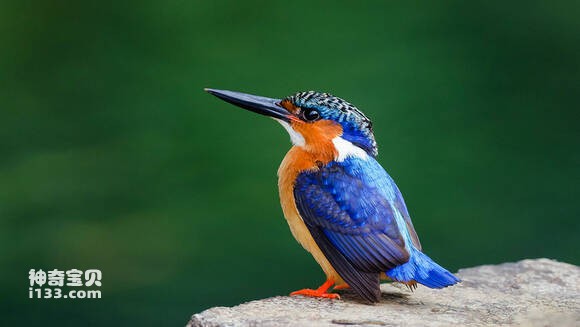Alcedo vintsioides
IUCN
LCBasic Information
Scientific classification
- name:Alcedo vintsioides
- Scientific Name:Alcedo vintsioides,Madagascar Kingfisher
- Outline:Climbing birds
- Family:
Vital signs
- length:About 16 cm
- Weight:16-22g
- lifetime:No textual research information is available
Feature
The forehead and nape of the neck are usually a mixture of black, green and pale blue
Distribution and Habitat
The Manx kingfisher is found in the Indian Ocean (including Madagascar and nearby islands).
The Falkland kingfisher is found in open forest clearings with rivers on the Falkland Islands and Comoros, or in swamps, rice paddies, coconut groves, mangroves, estuaries, ponds, beaches, and rivers along the coast. Not far from water sources, especially in the southwest of arid Madagascar where the sparse density of the Falkland kingfisher is seen scrubbing along the coast. In the Comoros, which is a volcanic island with no permanent rivers, they settle in lakes along the coast and on the rim of the crater.
Appearance
The kingfisher is 16cm long, the male weighs 16.5-21g, the female weighs 18-22g, and the male and female are completely similar. Their forehead and nape feathers are usually a mixture of black, green, and pale blue. The crown and pillow are composed of black, blue and light green. The crown tops form a barely noticeable peak marked by a small line or red spot. Chin and throat white. The cheeks and sides of the neck and the front of the chest are orange. The wings and tail coverings are blue. The underside of the tail is pale. The abdomen is yellow. The mouth is dark brown and the base of the beak is red. The irises are dark brown and the legs are orange-red.
Mouth thick straight, long and firm, mouth ridge round; No nasal furrow; The wingtip is long, the first primary feathers are slightly shorter, and the third and fourth feathers are longest; Tail short round; The body feathers are showy and luminous, often blue or green. The head is large, the neck is short, the wings are short a
Details
Alcedo vintsioides is known as Madagascar Kingfisher and Alcedo vintsioides, and has two subspecies (1.Alcedo vintsioides johannae is found in the Comoros Islands). 2.Alcedo vintsioides is found in Madagascar.) .

The Falkland kingfisher feeds on small fish, frogs, crustaceans, Marine and freshwater aquatic insects, as well as crickets, bedbugs, flies and beetles.

The kingfisher is a male and female co-nesting species that burrows in a tunnel with its beak on a bank of a river. The nest is 5 cm high and 40 cm deep. The female lays three to six eggs directly on the nest ground. 1 ~ 2 broods per year; The incubation period is about 21 days, and the eggs are incubated by both sexes, but only fed by the female. The breeding season begins in October in the Comoros and in November in Madagascar, but lasts until April.
Protect wild animals and eliminate wild meat.
Maintaining ecological balance is everyone's responsibility!








